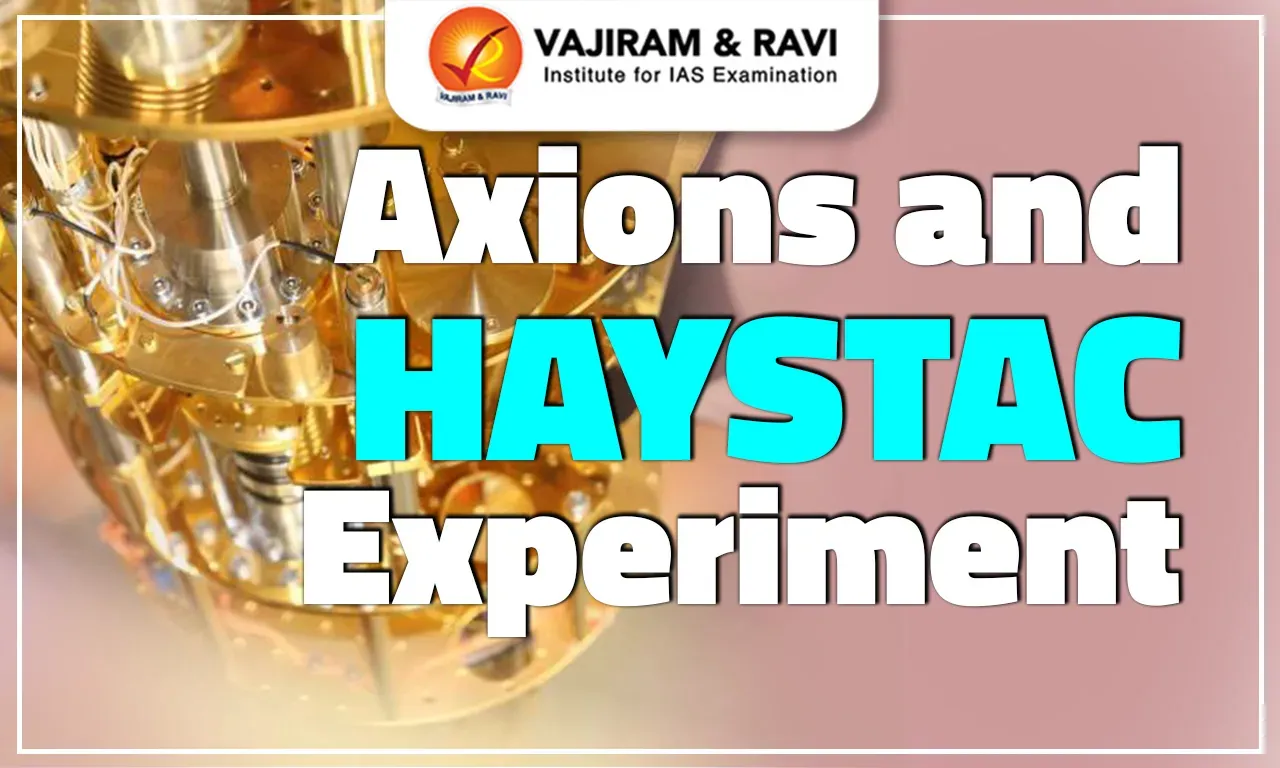Axions and HAYSTAC Experiment Latest News
The HAYSTAC results, published in Physical Review Letters, marked a technological advance, even though no axions were detected. The experiment significantly expanded the parameter space of axion mass and coupling strength.
What are Axions?
- Axions are hypothetical subatomic particles originally proposed in the late 1970s to explain the strong CP problem in quantum chromodynamics (QCD). They later emerged as one of the most promising candidates for dark matter.
- The axion’s role was to suppress CP-violating terms in QCD by dynamically adjusting the theta parameter (θ) to nearly zero.
Axions as Dark Matter Candidates
- Over time, axions emerged as a leading dark matter candidate due to their unique properties:
- Electromagnetically neutral,
- Extremely light,
- Very weak interaction with ordinary matter and radiation.
- They are hypothesised to make up Cold Dark Matter (CDM)—the dominant form of dark matter thought to constitute ~85% of the universe’s matter content.
- Pioneering work by Sikivie, Wilczek, Dine, Preskill, and others showed that cosmological production of axions in the early universe could match observed dark matter density.
What is HAYSTAC?
- The HAYSTAC experiment (Haloscope At Yale Sensitive To Axion Cold dark matter) is a collaborative initiative between Yale, Berkeley, and Johns Hopkins, aimed at directly detecting axions by exploiting their potential to convert into photons within a strong magnetic field.
- The experiment uses a haloscope—a special type of detector designed by Pierre Sikivie—which incorporates a microwave cavity inside a powerful magnetic field.
- In its Phase II, HAYSTAC conducted the widest frequency search for dark matter axions to date. It introduced quantum squeezing techniques to reduce quantum noise, thereby enhancing the sensitivity of its haloscope detector.
- The HAYSTAC experiment and Advanced LIGO are currently the only two major physics experiments utilising quantum squeezing to improve precision in measurements.
- Quantum squeezing involves manipulating the uncertainty in quantum states to suppress random fluctuations, which improves the signal-to-noise ratio in weak signal detection, especially important for identifying rare particles like axions.
Axions and HAYSTAC Experiment FAQs
Q1: What are axions?
Ans: Axions are hypothetical subatomic particles proposed as a solution to the strong CP problem in quantum chromodynamics and are considered candidates for dark matter.
Q2: What is the HAYSTAC experiment?
Ans: HAYSTAC (Haloscope at Yale Sensitive to Axion CDM) is a U.S.-based experiment designed to detect axions as a form of cold dark matter using a microwave cavity and magnetic fields.
Q3: How does HAYSTAC aim to detect axions?
Ans: It uses resonant conversion of axions into microwave photons in a strong magnetic field, leveraging the axion-photon coupling.
Source: PHY
Last updated on December, 2025
→ Check out the latest UPSC Syllabus 2026 here.
→ Join Vajiram & Ravi’s Interview Guidance Programme for expert help to crack your final UPSC stage.
→ UPSC Mains Result 2025 is now out.
→ UPSC Notification 2026 is scheduled to be released on January 14, 2026.
→ UPSC Calendar 2026 is released on 15th May, 2025.
→ UPSC Prelims 2026 will be conducted on 24th May, 2026 & UPSC Mains 2026 will be conducted on 21st August 2026.
→ The UPSC Selection Process is of 3 stages-Prelims, Mains and Interview.
→ UPSC Result 2024 is released with latest UPSC Marksheet 2024. Check Now!
→ UPSC Toppers List 2024 is released now. Shakti Dubey is UPSC AIR 1 2024 Topper.
→ Also check Best IAS Coaching in Delhi
Tags: Axions and HAYSTAC Experiment prelims pointers upsc prelims current affairs

















